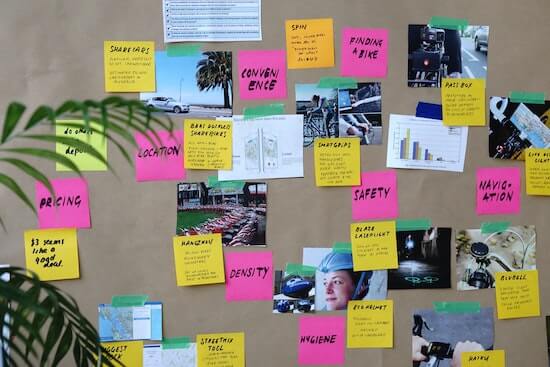Product in Practice: Getting Engineers Involved in Brainstorming

Getting a group together to generate ideas—an activity often referred to as “brainstorming”—doesn’t always go smoothly.
In the past, Teresa has written about the major reasons why traditional brainstorming doesn’t work: social loafing (people tend not to work as hard in a group setting), conformity (people are afraid to stand out with ideas that are too distinct from the rest of the group), production blocking (we get distracted by what other people are saying), and downward norm setting (teams tend to perform at the level of their weakest member).
But there are still benefits to generating ideas in a group setting. Teresa wrote:
“When tackling new problems, we each bring our own unique perspective to the situation, based on our past experience with those types of problems.
Each person on your team represents a unique set of experiences and thus brings a fresh perspective to the situation. Your goal should be to capture as many of those perspectives as possible.”
So how do you overcome the challenges associated with brainstorming and make sure you capture the full diversity of your team’s perspectives?
Today’s Product in Practice focuses on Ellen Juhlin, a Product Talk Academy instructor, product coach and consultant, and Senior Director of Product Management at Orion Labs, who recently found herself facing this challenge. When running brainstorming sessions, Ellen found that engineers in particular were quick to jump to feasibility concerns. In other words, rather than focusing on idea generation, they wanted to skip ahead to idea evaluation.
Ellen shared her challenge with the Continuous Discovery Habits Slack community and was able to use this feedback to make some changes to the way she approached brainstorming. We caught up with Ellen to find out what she ended up doing and how the advice from the community has informed her thinking about brainstorming in general.
Do you have a Product in Practice or success story from the Continuous Discovery Habits community you’d like to share? You can submit your story here.
A Quick (Re-)Introduction to Ellen and Her Challenge
Ellen’s name may sound familiar if you’re a regular Product Talk reader or member of the Continuous Discovery Habits community, because Ellen has been featured in a previous Product in Practice about involving engineers in discovery, she’s an active member of the CDH community, and she’s one of the newest instructors to join Product Talk Academy.
But in case you’re not familiar with Ellen and her work, here’s a quick overview. Ellen is the Senior Director of Product Management at Orion Labs, a B2B company that offers voice communication to teams in industries like hospitality, retail, transportation, logistics, and security. Their core product offers instant voice communication like a walkie-talkie, but reinvented so it can be integrated with other web services and offer more context like location and online status.
Ellen was recently working on a new direct messaging feature that had been much requested by Orion’s customers, and all the stakeholders had agreed that it was a top priority. But, Ellen says, “Since our apps had been originally designed for group messaging, there wasn’t a clear or obvious solution for how to add this to our mobile app UI in a way that would meet the key needs we had heard about from our users. The back-end platform already supported the ability for direct messaging, so there was very little technical feasibility we had to worry about—the interface and user experience were the main challenges.”
To come up with solution ideas, Ellen started running solution brainstorming sessions with the team. But she was coming up against a bit of a roadblock. Here’s how she explained it to the CDH community:
Looking for some tips on running brainstorming sessions. We’re short a designer at the moment, so I have been doing some solution brainstorming sessions primarily with a couple of engineers. I will always do quiet/individual brainstorming for five minutes or so and then have folks take turns sharing the ideas they came up with. I’ve tried to stress things like, “Let’s get as many solutions as possible, even if they are super ambitious or not practical,” etc., but during the sharing of ideas they can sometimes be quick to jump to feasibility concerns. And it’s totally understandable since some of them are still new to this process. I feel bad saying things like, “Let’s put that aside for the moment,” since I feel like I’m shutting down their contributions, and that goes against the spirit of creativity that I’m trying to foster. Anyone have tactical tips for helping engineers get out of the feasibility space during brainstorming and sharing ideas?
Suggestions from the Community for Better Brainstorming
As is often the case, the CDH community was quick to jump in and offer advice to Ellen. Here were a few of the suggestions they shared:
- Maybe experiment with a rule like: “Everyone should generate at least three impossible ideas.”
- Teach them how to look for inspiration from analogous products. Remind them with analogous products that they can and should go far from your field or domain.
- Review chapter 8 of Continuous Discovery Habits for more tips on how to get unstuck.
- Try a warm-up round to loosen up the feasibility mindset. For example:
- Write down as many ideas that would do the exact opposite of what we are trying to accomplish.
- Imagine that we can use magic for our solutions (to stretch the moonshot thinking even more).
- Check out the Lightning Decision Jam, which can help when people try to kill ideas too early.
Ellen’s Responses and Next Steps

Ellen was grateful that the CDH community stepped in with all these suggestions, but she admits she was also hesitant to try some of them out with this group. She explains, “Since some of the folks in this particular group seemed self-conscious about brainstorming, I was concerned about the idea of adding more brainstorming that might seem irrelevant to them. Instead, I made a couple changes in future sessions.”
Here are the changes Ellen ended up making:
- When they were doing their second round of brainstorming, she brought up some products that had similar features to consider as inspiration.
- Ellen did some more framing before they started brainstorming, focusing on quantity over quality, and reminding them that editing the ideas had a specific time after generating and sharing the ideas. “This got easier with repetition, and they could trust that technical concerns could be raised and considered,” says Ellen.
- Ellen was always encouraging of new ideas at any stage of the process, and she started a pattern of soliciting new ideas at the start of each session to fully incorporate them into the pool of ideas for further consideration. “It’s inevitable that new ideas will come up while story mapping or identifying assumptions, or even waking up in the middle of the night with a new idea,” says Ellen. Anytime someone comes to her with a new idea, she’ll say something like, “That’s a great idea! I’ll add that to our solution space.”
- The other long-term tactic Ellen tried was to gently redirect any input to the appropriate phase of the process. If a technical concern was raised while brainstorming, she’d make sure to say something like, “That’s a great assumption to identify. I’ll put that on a sticky note over here so we don’t forget it.”
The Results: A Surprising Discovery

It’s been a gradual process of helping everyone feel more comfortable with brainstorming and the distinction between idea generation and idea evaluation, but Ellen has seen some tangible results. “When people see that you are receptive to their input, and can see their words written down and considered in a way that removes the loudest voice/HiPPO effect, then they feel safer when sharing new ideas,” says Ellen.
Approaching brainstorming this way also led Ellen to make a surprising discovery. Ellen says, “I also learned that the team didn’t share the stakeholder’s alignment around the priority of what we were discussing. They were concerned that it was too far outside our core offering, and that we would be trying to compete on features with much bigger companies.”
But instead of being a problem, Ellen explains, “This opened the door for me to share some additional strategic context. We weren’t trying to go head-to-head with other messaging services. Instead, we were trying to meet the table-stakes feature offering of our direct competitors.”
Key Learnings and Takeaways
Since Ellen was still getting her team up to speed with the continuous discovery process, she wanted to make sure not to have them associate it with activities that might be outside their comfort zone. That’s why she chose to focus on the tactics that might feel a little more familiar, like looking at other products with similar or related features. “However, I don’t think I would have realized that that direction was necessary without contemplating the other suggestions that folks provided,” says Ellen.
“I always appreciate the answers that I see in the CDH community, and this time was no exception,” says Ellen. “Some of these suggestions I have filed away for future design workshops where we have a little more time to get into a creative mindset, or where I know I’ll have at least one other participant who is excited about creative activities.”
The Continuous Discovery Habits community is the ideal place to share your challenges and get feedback from like-minded peers. Come join us there!




Comments ()